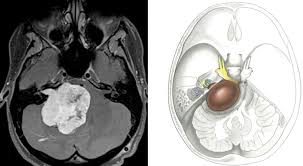An acoustic neuroma is a noncancerous growth that develops on the eighth cranial nerve. Also known as the vestibulocochlear nerve, it connects the inner ear with the brain and has two different parts. One part is involved in transmitting sound; the other helps send balance information from the inner ear to the brain.
Progression to malignancy in this kind of tumor is rare. They normally develop gradually over a period of years, expanding at their site of origin roughly 1–2 mm each year.
Tumors are typically described as small (less than 1.5 cm), medium (1.5 cm to 2.5 cm), large (2.5 cm to 4 cm), or giant (greater than 4 cm).
Most schwannomas start out as intracanalicular, and growth compresses the nerve against the bony canal, so the first symptoms of the tumor are unilateral sensorineural hearing loss or disturbances in balance.
As intracanalicular tumors grow, they tend to expand into the cerebellopontine angle (CPA), leading to their characteristic “ice-cream-cone like” appearance on a radiograph.
As the schwannoma expands into the CPA, it may infringe on cranial nerve V (controls facial sensation, chewing and swallowing) and cranial nerve VII (controls facial expression and taste)
There are two types of acoustic neuroma: a sporadic form and a form associated with a syndrome called neurofibromatosis type II (NF2). NF2 is an inherited disorder characterized by the growth of noncancerous tumors in the nervous system. NF2 is a rare disorder. It accounts for only 5% of acoustic neuromas

